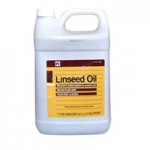Linseed Oil
 Linseed oil, also known as flax seed oil is a colourless to yellowish oil obtained from the dried, ripened seeds of the flax plant. The oil is obtained from pressing, sometimes with solvent extraction after.
Linseed oil, also known as flax seed oil is a colourless to yellowish oil obtained from the dried, ripened seeds of the flax plant. The oil is obtained from pressing, sometimes with solvent extraction after.
Pure linseed oil is non-drying and therefore it is not practical for a wood finish. Boiled linseed oil is what is used for wood finishing. Boiled linseed oil is made in two different ways; it either has a heavy metal dryer added to it or it is boiled to 500 degrees Fahrenheit in an oxygen free environment.
When applied to wood, linseed oil seeps into the grain of the  wood, giving it a perpetual wet look that highly accentuates the look of the grain. It will add a slightly yellow tint to wood, which will darken with age.
wood, giving it a perpetual wet look that highly accentuates the look of the grain. It will add a slightly yellow tint to wood, which will darken with age.
The advantages to linseed oil are:
- Water resistance, although if water is left on surface for too long it can absorb and leave a water stain.
- It is flexible and continues to protect with the expansion and contraction of wood.
- Accentuates texture of grain.
- Easy to apply and forgiving during application.
- Easy to reapply if damaged.
The disadvantages of linseed oil are:
- Lack of UV inhibitors.
- Can support growth of mildew.
- Poor abrasion resistance.
In all linseed oil would not be recommended for furniture that gets a high amount of use. Instead it should be used for projects where you would want the look and feel of the wood, but is not a high use item.